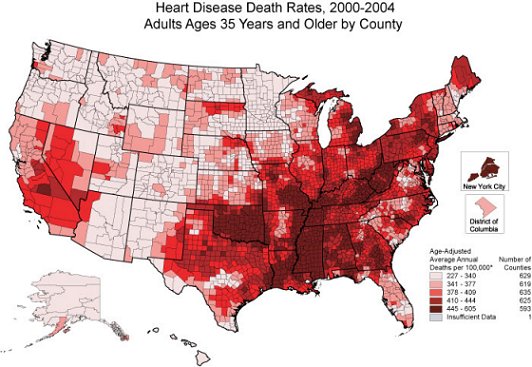Description of Health Issue
Heart diseases and strokes are common causes of adult mortality in America. These health conditions cause disability and contribute to high health care costs. For example, Healthy People (2014) say, in the US, heart diseases account for about $500 billion in health care costs. Common modifiable factors that could lower the incidence of heart disease and stroke are blood pressure, smoking, and physical activity (Healthy People, 2014). These lifestyle factors could improve, or worsen, health outcomes in this regard (Centers for Disease Control and Prevention, n.d.). Modern statistical tools, such as the Geographic Information Systems (GIS), could also help to manage these health issues. The following section of this report explains how the Geographic Information System (GIS) and health informatics help to do so.
How to apply Geographic Information Systems (GIS) in evaluating the Health Issue
GIS is a collection of science and technology tools that define health issues according to their geographic characteristics (Centers for Disease Control and Prevention n.d.). Through spatially referenced data, GIS is instrumental in helping health care service providers to make well-informed decisions about the geographical characteristics of health data. In the context of this study, it is helpful in identifying the incidences, or risk factors, associated with heart diseases and stroke, according to varying geographical characteristics. The National Center for Chronic Disease and Prevention has used the tool to create and display interactive maps showing the incidence of the health problem, across different states, counties, and ethnicities in America (Centers for Disease Control and Prevention n.d.). For example, the map below presents a graphical representation of the incidences and ethnic distribution of heart disease and stroke in America (Using GIS).

The diagram above shows how GIS maps out the digital databases of heart diseases and stroke in the US. The use of GIS also stretches to health care decision-making because health agencies have used it in health promotion and health prevention programs (Centers for Disease Control and Prevention n.d.).
How Health Informatics Technology Informs and Supports the Strategic Planning Process
Health informatics describes a set of computerized techniques for managing health data (Ciampa & Revels, 2012). They include tools and techniques that secure information exchanges among customers, health practitioners, government entities, insurance brokers and other health stakeholders (Ciampa & Revels, 2012). Based on its usefulness in managing health data, users perceive it as a promising tool for improving the quality and efficiency of health programs (Public Health Informatics Institute, n.d.). Based on these contributions, it supports strategic planning processes through the early detection of health issues and the tracking of chronic heart diseases. These contributions improve the efficiency of heart disease management and prevention programs (Ciampa & Revels, 2012). Therefore, the diagnosis of heart diseases and strokes could improve through easy information exchanges. Similarly, through improved information access, patients would have more information to manage their health. At a policy level, health informatics could improve the quality of clinical research, about heart diseases, and answer policy questions about the same. Collectively, these factors show how data management tools support strategic planning processes.
Alternative ways of How GIS helps in Health Impact Assessments
This paper has already shown that GIS helps to map health issues across different populations. However, the tool is also instrumental in showing the correlation between health issues and lifestyle factors. For example, medical researchers have used it to show the correlation between Hepatitis C and injecting drug users (Ciampa & Revels, 2012). In the context of this study, it could be useful in understanding the relationship between lifestyle factors and heart diseases. Although it is difficult to find out the absolute correlation between health variables, GIS also helps to accept such relationships. In the same regard, GIS could help to create a proper understanding of heart diseases and stroke, thereby enabling people to make better decisions about lifestyle factors that cause the health conditions (Ciampa, & Revels, 2012). These contributions do not necessarily have to occur at a personal level, because at a policy level, they could also help to eliminate disparities and inequalities that hamper the realization of positive health outcomes (Centers for Disease Control and Prevention, n.d.). In this regard, policymakers would be better equipped to develop solutions for managing such shortcomings.
How Health leaders Could use their Leadership Skills to Manage Data and Informatics
Unlike past years, today, health care practitioners have huge volumes of data for developing health prevention and promotion programs (Ciampa & Revels, 2012). Based on this change, leaders need to develop, or learn, new skills to manage data and informatics in the health sector (Public Health Informatics Institute, n.d.). For example, they need to learn how to discover patterns in health data. Similarly, they need to find new relationships in complex data (Ciampa & Revels, 2012). In line with this need, health leaders could use their leadership skills to analyze and visualize data. Since not all leaders have these skills, Ciampa and Revels (2012) propose that such leaders should realize that outsourcing is a prudent decision for managing the huge volumes of data gathered from modern data management tools. This means they should seek the services of data mining experts, statisticians, actuaries, and such like professionals. Comprehensively, prudent leaders could exploit the advantages of modern data management tools if they adopt effective leadership skills.
References
Centers for Disease Control and Prevention. (n.d.). Geographic information systems (GIS) at CDC. Web.
Ciampa, M., & Revels, M. (2012). Introduction to Healthcare Information Technology. London, UK: Cengage Learning.
Healthy People. (2014). Heart Disease and Stroke. Web.
Public Health Informatics Institute. (n.d.). Collaboration & Innovation for Public Health. Web.